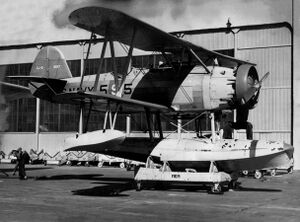Engineering:Berliner-Joyce OJ
| Berliner-Joyce OJ | |
|---|---|

| |
| OJ-2 at NAS San Diego | |
| Role | Observation |
| National origin | United States |
| Manufacturer | Berliner-Joyce Aircraft |
| First flight | 1931 |
| Introduction | 1933 |
| Retired | 1941 |
| Primary user | United States Navy |
| Number built | 39[1] |
The Berliner-Joyce OJ was an American biplane observation floatplane developed by the Berliner-Joyce Aircraft for the United States Navy during the early 1930s.
Design and development
The origins of the OJ stemmed from a 1929 Bureau of Aeronautics (BuAer) requirement calling for an observation seaplane intended for service aboard Omaha class light cruisers, readily convertible to wheels or floats and light enough to operate from the cruiser-type catapult.[1] Prototypes were ordered from Keystone-Loening (then a subsidiary of Curtiss-Wright), Berliner-Joyce and Vought, and designated as the XOK-1, XOJ-1 and XO4U-1 respectively.
The Berliner Joyce design, a conventional biplane of mixed metal and fabric construction with staggered wings and the pilot and observer seated in tandem in open cockpits, first flew in May 1931. By that time the rival XOK-1 was already destroyed in a crash. Following trials that lasted into 1932, BuAer awarded Berliner-Joyce a contract.[1]
An order for 18 production aircraft designated OJ-2 was placed in March 1932, and two more orders followed, one in May 1933 for nine aircraft and a further 12 aircraft in December 1933 for use by reserve units.
One OJ-2 modified in early 1934 with an NACA-type cowling and enclosed cockpits was delivered for trials as the XOJ-3, but after a crash it was rebuilt and returned to service as an OJ-2.[1]
Operational history
The OJ entered service with VS-5B and VS-6B in 1933 mainly for use on Omaha class light cruisers. Some OJs were used by reserve units with the first being VN-6R which were based near Washington to train reserve pilots and to enable staff officers to maintain their flying categories. By 1936 all the remaining aircraft were operated by reserve units and at the outbreak of the Second World War 29 aircraft were still in service. The Navy stopped the overhaul program for the aircraft and by the middle of 1941 all of them had been struck off charge.
Unusually for its generation, only four aircraft were lost in accidents without any loss of life.
Variants
- XOJ-1
- Prototype powered by a 400hp R-985-1 Wasp Junior radial engine, one built.
- OJ-2
- Production variant which had interchangeable floats or wheeled landing gear, 39 built.
- XOJ-3
- One production OJ-2 modified with NACA cowling and enclosed cockpit; later reverted to the standard OJ-2 configuration and returned to service.
Operators
 United States
United States
- United States Navy
- VS-5B
- VS-6B
Specifications (OJ-2)
General characteristics
- Crew: 2 (pilot and observer)
- Length: 25 ft 8 in (7.82 m)
- Wingspan: 33 ft 8 in (10.26 m)
- Height: 10 ft 10 in (3.30 m)
- Wing area: 284.2 sq ft (26.40 m2)
- Empty weight: 2,323 lb (1,054 kg)
- Gross weight: 3,629 lb (1,646 kg)
- Powerplant: 1 × Wright R-975-88 Wasp Junior radial engine, 400 hp (300 kW)
Performance
- Maximum speed: 151 mph (243 km/h, 131 kn)
- Stall speed: 57 mph (92 km/h, 50 kn)
- Range: 530 mi (850 km, 460 nmi)
- Service ceiling: 15,300 ft (4,700 m)
- Rate of climb: 826 ft/min (4.20 m/s) , climb to 10,000 ft in 12.1 min
Armament
- Guns: 1× fixed, forward firing .30 in machine gun, 1× flexibly mounted .30 in machine gun in the rear cockpit
- Bombs: 250 lb (110 kg) bombs under wing
See also
Aircraft of comparable role, configuration and era
Related lists
- List of United States Navy aircraft designations (pre-1962)
- List of flying boats and floatplanes
References
Citations
- ↑ 1.0 1.1 1.2 1.3 Johnson, E.R. (2011). United States Naval Aviation 1919-1941. Aircraft, Airships and Ships Between the Wars. Jefferson, North Carolina, and London: McFarland & Company, Inc.. pp. 118–119. ISBN 978-0-7864-4550-9. https://archive.org/details/unitedstatesnava00john.
- ↑ Swanborough, Gordon; Bowers, Peter M. (1976). United States Navy Aircraft since 1911. London: Putnam. pp. 415. ISBN 0-370-10054-9.
- ↑ "Foreign Aircraft:The B/J OJ-2 Observation Aircraft". Flight (10 May 1934): 468. http://www.flightglobal.com/pdfarchive/view/1934/1934%20-%200468.html.
- ↑ Sharpe, Michael (2000). Biplanes, Triplanes, and Seaplanes. London: Friedman/Fairfax Books. pp. 78. ISBN 1-58663-300-7.
Bibliography
- Andrade, John (1979). U.S.Military Aircraft Designations and Serials since 1909. Midland Counties Publications. ISBN 0-904597-22-9.
- "Foreign Aircraft:The B/J OJ-2 Observation Aircraft". Flight (10 May 1934): 468. http://www.flightglobal.com/pdfarchive/view/1934/1934%20-%200468.html.
- Listemann, Phil (Winter 2004). "Berlin-Joyce OJ". Air-Britain Aeromiltaria 30 (120): 158–163. ISSN 0262-8791.
- Swanborough, Gordon; Bowers, Peter M. (1976). United States Navy Aircraft since 1911. London: Putnam. ISBN 0-370-10054-9.
 |

